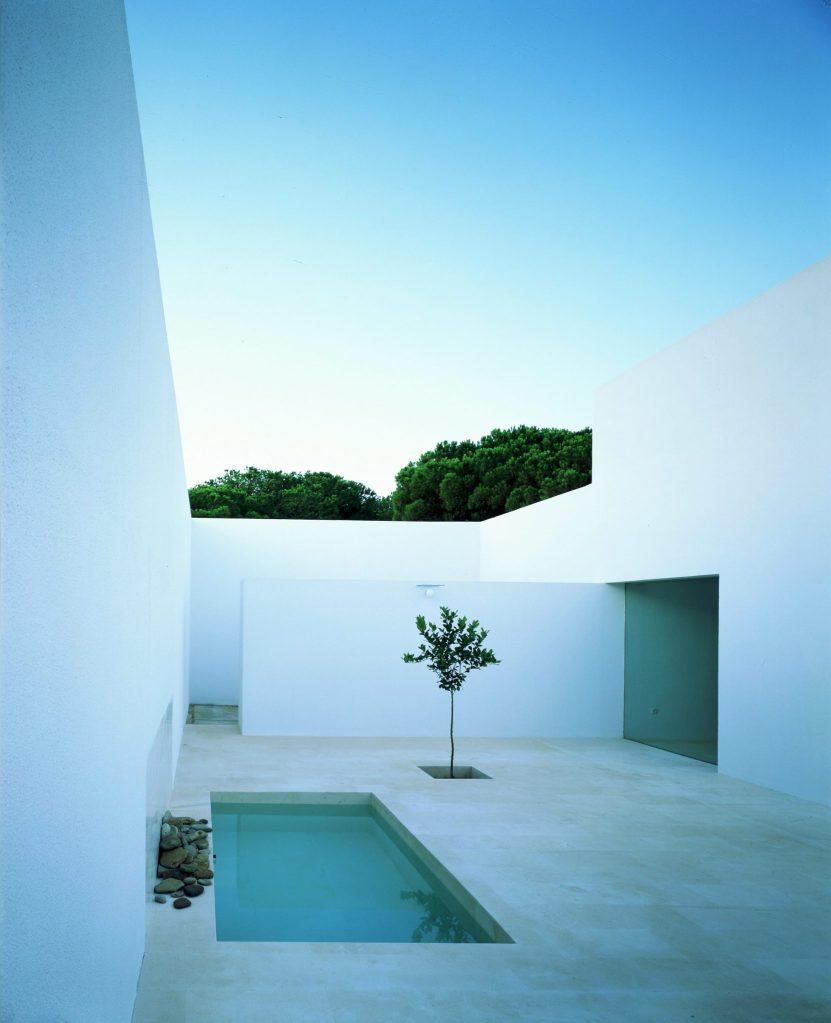The room with no roof
Author: Alejandro Pérez García
‘The room with no roof‘ lacks a definite form and, at the same time, presents all possible contours, because ‘the room with no roof‘ has transcended the limits of Cartesian geometry. In its walls, always white, smooth and of indecipherable thickness, there are no doors or windows, so there is no need for keys, locks or handles. Its only opening is at the top, at a height difficult to measure, where the walls, as high as only human perception can conceive, seem to caress an ever-changing sky.
The floor of ‘the room with no roof‘ is made of pressed earth, and sinks slightly when bare feet pass through it. In the mornings, small drops of dew condense between the outbreaks of wild vegetation that, with the passing of days, begin to colonise its surface. The strands of wet grass seem to whisper confidences to the skin of the solitary inhabitant who, by wandering in random and aimless walks, imprints on the green mantle the hidden trace of his destiny. The paraments, on the other hand, are no strangers to the passage of days and mutate in colour, from the most pristine of whites to more ashy tones, when the inclemencies and rigours imposed by the succession of the seasons attack their solid anatomy.
In its interior reverberate music learned from all eras, present, past and yet to come, which end up generating an eternal melody in perpetual change. The distant sounds of the anonymous crowd join, in their corners, old known voices and future songs that have not yet been composed and, perhaps, unfortunately, never will be.
Situated in the centre of ‘the room with no roof‘ is a fire that will never be extinguished, an incandescent flame, always alive and powerful that, sometimes, if it is not cared for with affection, will with the passing of time become too fragile and brittle. The inhabitant, aware that his destiny is inevitably linked to that of the bonfire that feeds him, watches over it at all times, receiving the crackling of his embers as the most sincere of laughter.
Of indecipherable location, ‘the room with no roof‘ is a place to escape, to sensorially stimulate body and soul. It is an area dedicated to the most honest of introspections, an environment in which to face, in solitude, the most inclement of interlocutors, oneself. It is not, therefore, a space for coexistence, but the arrival of a new user is, irremediably, the farewell to the previous one.
It is, in short, an inherited home, which one cannot appropriate if not because it has been voluntarily and freely given to it.
‘The room with no roof‘ smells of darkness in autumn, of salt in summer and of wood in winter; in spring, however, when flowering imprints saturated tones to its atmosphere, it inevitably becomes erotic and nudity becomes both necessary and unavoidable.
Of oneiric nature, at night it reaches all its splendour. Just when darkness encompasses everything and the gaze is lost beyond the horizon, its limits seem to change and diffuse and even seem to dilute completely. Before the attentive presence of the Moon, the inhabitant then feels free, and without frontiers or impediments, without shame, blush or shyness, one becomes one with ‘the room without a roof‘ and fuses with it in an eternal embrace that will take him beyond the limits of time and reason.
‘The room with no roof‘ is quiet, calm and peaceful. Within its walls there is no room for stress, shouting or violence. ‘The room with no roof’ is architecture for peace and happiness, for self-knowledge and acceptance. It is the engine of change and transformation, it is evolution.
It is a space as real as it is figurative, as concrete as it is imagined. ‘The room with no roof‘ is the purest and most marvellous of conceivable dwellings, because, despite its simplicity, it is built with the two faces of the highest of materials: Light and Time.
It is fiction and reality at the same time, because it is constructed through indeterminations that are concatenated with no other criterion than that of one’s own intuition and experience. It lacks absolute certainties, guarantees and categorical affirmations. In it everything seems possible and, at the same time, it seems absolutely unfeasible.
‘The room with no roof’ is both all and nothing.
‘The room with no roof’ is, in the end, somebody sititng in front of a white sheet of paper, holding a pencil with its hand.
It is to think, to imagine, to dream.
‘The room with no roof’ is to create.

Would you like to send us some of your work? Do it now in our Call for Papers!





